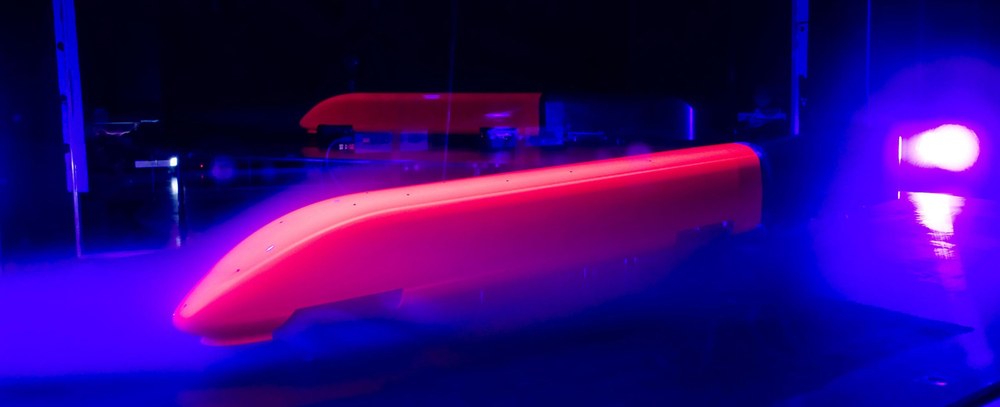Pressure Sensitive Paint (PSP)
The PSP technique is an optical measurement method, which provides a pressure measurement on surfaces without introducing flow-disturbing probes and without affecting the surface of the model. To obtain the surface pressure by this method, the model is coated with a special paint, which is illuminated for example by UV light. The intensity of the emitted light depends on the local oxygen concentration and allows for the determination of the two-dimensional pressure distribution.
At the DLR Institute of Aerodynamics and Flow Technology the application of pressure sensitive paint (PSP) is used as a tool to determine the pressure distribution on aircraft surfaces during aircraft design processes. Instantaneous two-dimensional pressure distributions on the surface of a model in test facilities like wind tunnels or turbo machines are considered a major advancement in the field of non-intrusive measurement techniques within aerodynamics.
While conventional pressure measurement methods are only capable to measure the pressure distribution on discrete points on the surface by installing pressure sensors such as taps and transducers, the two-dimensional PSP method provides a measurement of the entire surface. In addition, due to a better spatial resolution, disturbances in the flow are observable. Furthermore, costs for taps and transducers and for their installation can be saved. Finally, a major drawback of conventional pressure measurement technique is avoided by using PSP: The location of pressure taps must be determined prior to model manufacturing, at a time when the flow pattern is not known exactly. Also there are restrictions to drill holes in thin parts of wind tunnel models in order to install taps and transducers. These restrictions do not apply for a PSP coating applied to the surface of the model with a spray gun.

Generally, the PSP technique is based on an oxygen quenching process in which photo-chemical molecules excited by light are deactivated by collisions with oxygen molecules in spite of irradiation of fluorescence light. This leads to different degrees of luminosity on the surface of the model depending on the local pressure. A final pressure map is obtained from images of digital cameras using complex image processing techniques. With the software ToPas, developed at DLR, such pressure maps are made available during the test.
The sensitivity of the employed optical pressure sensor has been optimized in the pressure range of 0.1 – 1.5 bar. This is the typical pressure range, observable on models within the transonic flow range. Nevertheless the mobile DLR-PSP system has been successfully been used for applications in low speed and hypersonic wind tunnels. Under static conditions a resolution of up to ± 1.5 mbar with a response time of 0.5 s could be achieved. A "fast" PSP colour with a cut-off frequency of 5 kHz is available for transient measurements.
Applications
- Pressure determination for surfaces in wind tunnels in the following areas:
- Aeronautics
- Space
- Transport
- Propulsion technology
- Energy
- Measurement of unsteady effects
- Force and moment determination
- Transonic flows
- Low speed flows
- Hypersonic and short duration flows
- Unsteady flows
General data

- Location DLR Göttingen
- Opening 2006
- Method: Pressure-sensitive paint (PSP): optical technique for non-contact pressure measurements using the luminescence quenching effect caused by oxygen
Technical data
- Calibration chamber for pressure (1 - 300 kPa) and temperature (100 – 380 K)
- Calibration chamber to determine the transfer function (0.1 – 1,000 Hz)
- Spectrometer to analyse surfaces and optical filters (300 - 800 nm)
- CCD cameras and CMOS cameras
- High-speed cameras (50 Hz – 120 kHz)
- High-power light sources (lasers, discharge lamps, LED systems)
- Laboratories for sensor application and analysis
- mobile system
Project highlights
- VICTORIA - (Virtual Aircraft Technology Integration Platform, DLR)
Goal: further development of the TSP/PSP measurement method in order to determine the relative wall shear stress - FOR 2895
- Cryo-PSP: optical pressure measurement using pressure-sensitive paint under cryogenic flow conditions (LuFo IV-4)
